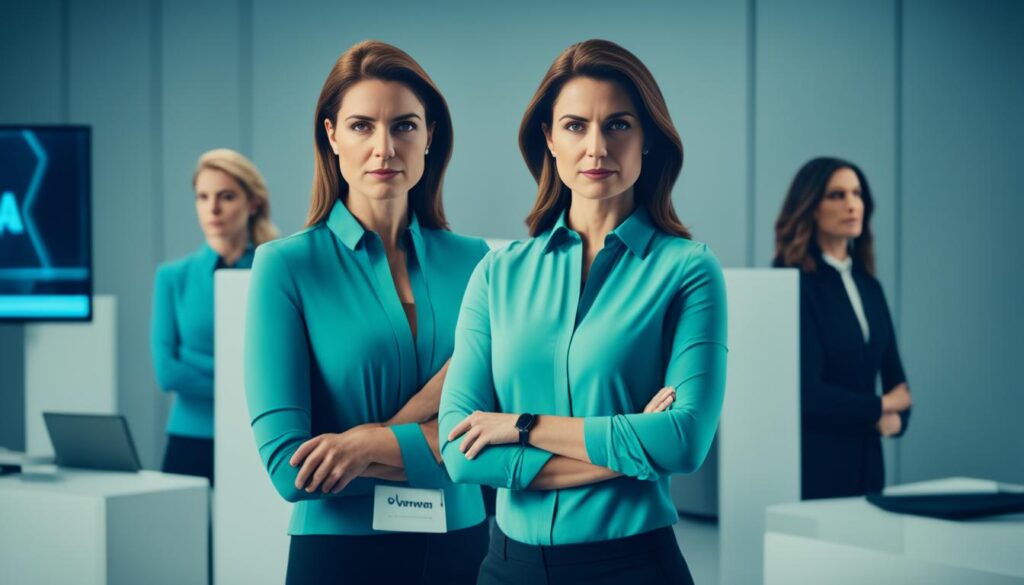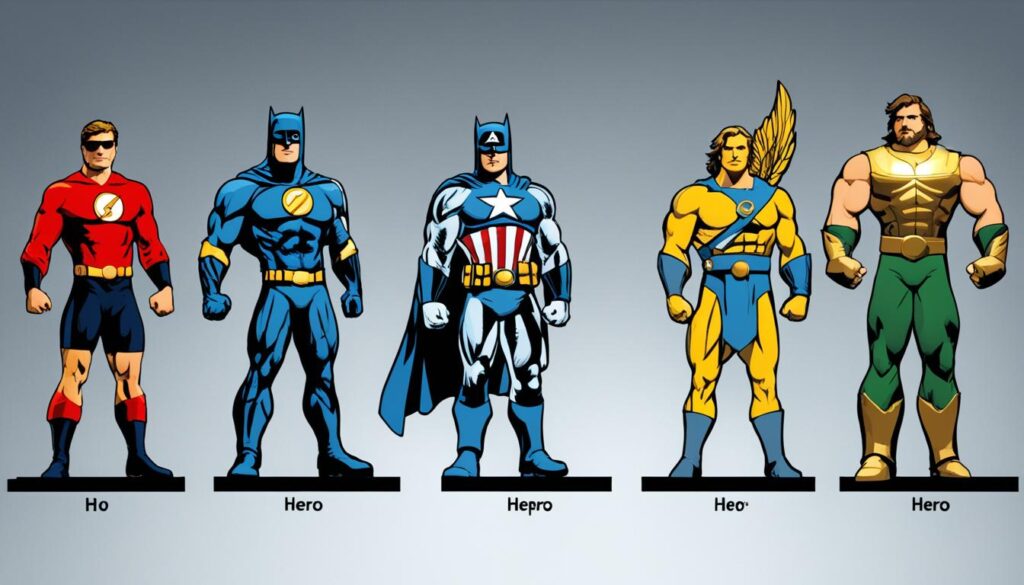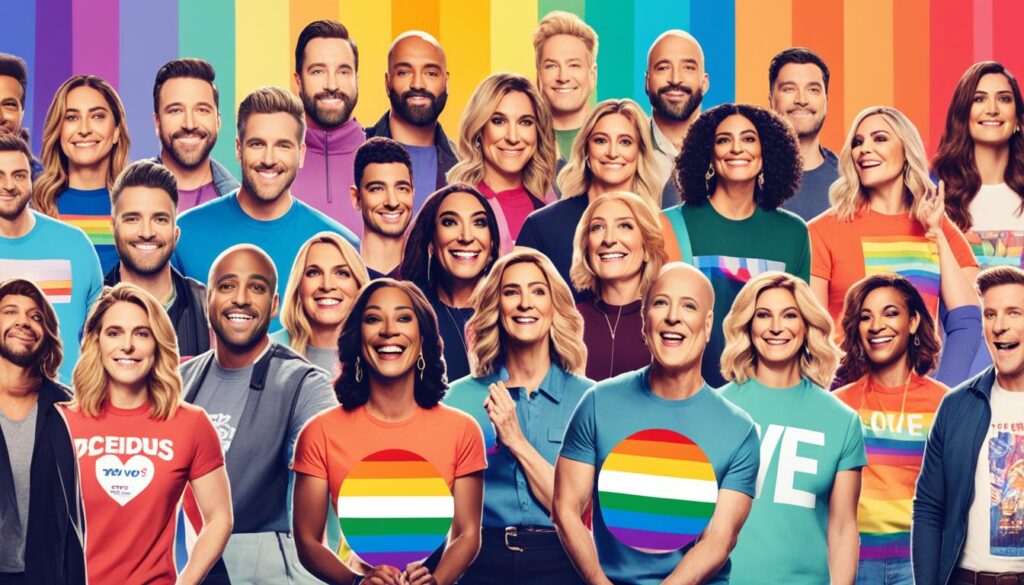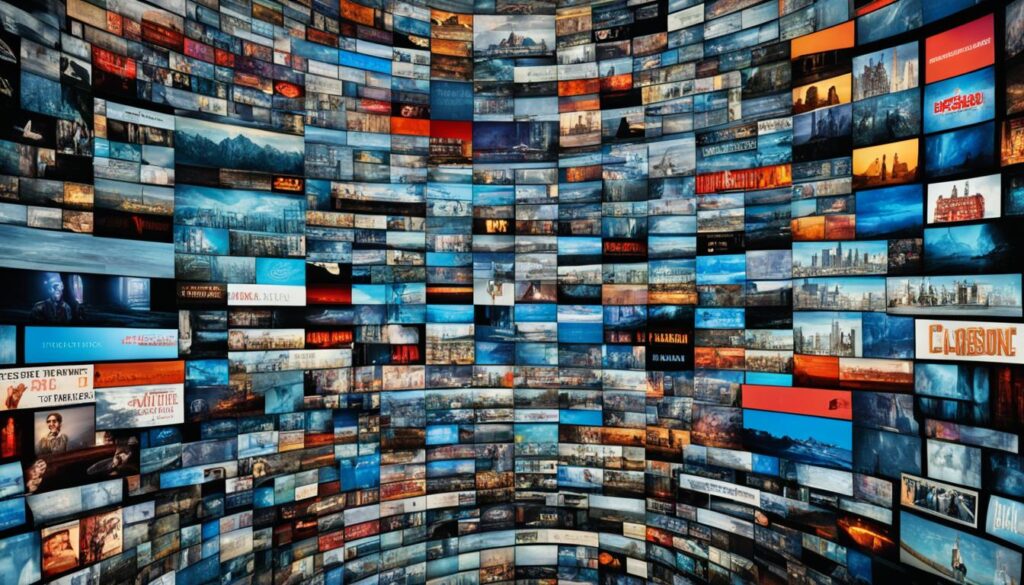Welcome to a journey through the ever-evolving landscape of on-screen representation in modern television. As we navigate the diverse narratives and characters that grace our screens, it’s essential to recognize the progress that has been made in terms of TV representation and on-screen diversity.
Television has come a long way in reflecting the rich tapestry of our society, embracing different ethnicities, cultures, genders, and sexual orientations. However, despite the advancements, there are still challenges and pitfalls in TV that need to be addressed.
In this article, we will explore the progress in television when it comes to representation and the opportunities and hurdles that exist in portraying a diverse range of characters. From the genesis of inclusivity in early television to the redefinition of female agency on screen, we will delve into the vast spectrum of on-screen diversity.
Through the lens of critical analysis and cultural insights, we will examine the gender and racial dynamics in contemporary storytelling and the impact of LGBTQ representation in mainstream TV. We will also shed light on the influence of technology in shaping TV diversity and the adaptation of classical narratives in the modern TV landscape.
Join me on this captivating odyssey, where we uncover the triumphs and tribulations in the world of on-screen representation. Let’s dive into the power and potential of diverse storytelling on our TVs.
Key Takeaways:
- The representation of diverse characters and narratives has improved in modern TV shows.
- Despite progress, challenges and pitfalls in on-screen representation still exist.
- Gender, race, and LGBTQ dynamics are important aspects of TV representation.
- Technology plays a significant role in increasing accessibility and diversity in television.
- The adapting of classical narratives in TV shows offers new perspectives and engagement.
Unveiling the Journey of Diversity in Television
The television industry has come a long way in terms of TV diversity and representation on screen. Efforts have been made to create more diverse characters in TV and promote inclusivity in television. These endeavors have had a significant impact on audiences, shaping their perspectives and opening up new possibilities for storytelling.
One of the key aspects in the journey of diversity in television is the increased visibility of underrepresented groups. TV shows now feature characters from a wide range of backgrounds, ethnicities, and cultures, providing a more accurate reflection of the real world. This newfound representation not only validates the experiences of marginalized communities, but also offers a platform for their stories to be told.
Inclusivity in television has evolved over time, with creators and networks recognizing the importance of authentic and nuanced portrayals. TV shows now strive to break stereotypes and depict characters with depth and complexity. By presenting diverse characters as fully realized individuals, television has the power to challenge preconceived notions and foster a greater understanding and empathy among viewers.
Representation on screen goes beyond just ticking boxes of diversity. It is about creating authentic and meaningful portrayals that resonate with audiences on a deep level.
The impact of diversity in television extends beyond entertainment. It has the potential to shape societal attitudes, challenge biases, and initiate conversations about important social issues. By showcasing diverse perspectives and experiences, television has the ability to educate and foster a more inclusive culture.
| Benefits of TV Diversity | Challenges in TV Representation |
|---|---|
|
|
The journey of diversity in television is an ongoing process that requires commitment from the industry and its stakeholders. It is essential to continue pushing boundaries, challenging norms, and advocating for inclusive storytelling in order to build a more equitable and representative television landscape.
Framing History: The Changing Faces of Television
Television has come a long way since its inception, evolving and adapting to the changing social fabric of our society. In this section, we will explore the historical context of on-screen representation in television and how it has evolved over time. From the genesis of inclusivity in early television to the growth of character complexity, we will delve into the changing faces of the small screen.
The Genesis of Inclusivity in Early Television
Early television shows laid the foundation for future developments in on-screen representation. In the early days, the representation of diverse characters was limited, with stereotypical roles prevalent. However, despite the limitations, these shows marked an important starting point for inclusivity in television. They paved the way for future creators to challenge the status quo and push for more authentic and diverse portrayals.
“Television can be an incredibly powerful medium for shaping public opinion and challenging societal norms. It was crucial for early television creators to begin advocating for more inclusive and representative storytelling, even in the face of resistance.”
This era of early television representation laid the groundwork for the industry to recognize the importance of diversity and representation on screen. The industry began to acknowledge that viewer experiences were enriched when they could see themselves reflected in the characters they watched, fostering a deeper sense of connection and understanding.
From Stereotypes to Depth: The Growth of Character Complexity
As television progressed, so did the development of characters. The growth of character complexity brought new dimensions to on-screen representation, challenging traditional stereotypes and introducing more nuanced portrayals. Characters started to break free from the confinement of one-dimensional archetypes, allowing for greater exploration of depth and realism.
This shift in character development opened up opportunities for actors to showcase their talent and for audiences to engage with more relatable and multifaceted characters. Rather than perpetuating stereotypes, television began to embrace the complexity of human nature and explore diverse experiences.
“Television has the power to redefine societal norms by presenting characters that defy stereotypes. By providing viewers with more complex and layered portrayals, the medium has the potential to challenge and reshape preconceived notions.”
In this journey from stereotypes to depth, television has played a pivotal role in shaping cultural attitudes and fostering empathy. By presenting characters with whom audiences can deeply identify, television has sparked conversations and allowed for a more inclusive and accurate representation of the diverse world we live in.

| TV History Milestones | Character Development Shifts |
|---|---|
| The advent of television | Introduction of one-dimensional, stereotypical characters |
| The genesis of inclusivity in early television | Early attempts at diverse representation, breaking away from stereotypes |
| Evolving societal norms | Shift towards more complex and nuanced character portrayals |
| Recognition of the importance of representation | Embracing diverse experiences and challenging traditional archetypes |
TV Show Recaps and Reviews: A Lens on Cultural Shifts
TV show recaps and reviews play a crucial role in analyzing the cultural shifts and evolving landscape of on-screen diversity. Beyond simply summarizing plot points, critics and reviewers offer valuable social commentary and in-depth analysis of the representation portrayed in television shows. Through their insightful perspectives, they bring to light defining moments in on-screen diversity that shape the broader cultural conversation.
Critiquing Beyond Plot: Social Commentary in TV Reviews
TV show reviews provide a platform for critics to delve into the social commentary present in the shows they analyze. By examining the themes, character dynamics, and storytelling choices, reviewers illuminate the cultural significance of television narratives. They explore how certain shows address social issues, challenge societal norms, and contribute to the broader discourse on topics such as race, gender, sexuality, and identity. Through their reviews, critics become cultural thought leaders, inviting audiences to engage critically with the content they consume.
“TV show reviews provide a platform for critics to delve into the social commentary present in the shows they analyze.”
Defining Moments in On-Screen Diversity
TV show recaps and reviews often highlight defining moments in on-screen diversity that resonate with audiences and shape the trajectory of representation in television. These moments can range from breakthrough portrayals of underrepresented groups to powerful storylines that challenge stereotypes and promote inclusivity. By shining a spotlight on these impactful instances, critics and reviewers contribute to the recognition and celebration of diverse voices and experiences in the TV landscape.
“TV show recaps and reviews offer a lens through which we can observe and appreciate the cultural shifts and progress in on-screen diversity.”
| TV Show | Defining Moment |
|---|---|
| The Handmaid’s Tale | Offred’s defiant act of resistance in the face of a tyrannical regime |
| Pose | The vibrant and authentic portrayal of LGBTQ+ ballroom culture |
| Black Mirror: San Junipero | The exploration of love and identity in a virtual reality setting |
| Brooklyn Nine-Nine | The celebration of diverse representation within a comedic ensemble cast |
| Orange is the New Black | The nuanced and complex depiction of incarcerated women from diverse backgrounds |
Table: Defining Moments in On-Screen Diversity
These defining moments showcase the power of television in challenging norms, expanding representation, and sparking important conversations. They demonstrate the impact of diverse storytelling and its ability to shape cultural perceptions and foster greater understanding.
TV show recaps and reviews offer a lens through which we can observe and appreciate the cultural shifts and progress in on-screen diversity. They play a vital role in enhancing our understanding of the social, political, and cultural implications of television narratives. By engaging with these critical perspectives, we can deepen our appreciation for the significance of representation in the ever-evolving TV landscape.
The Redefinition of Female Agency on TV
In recent years, there has been a significant shift in the portrayal of female characters on television. Women on TV are no longer confined to stereotypical roles or one-dimensional characters. Instead, they are being portrayed as empowered and complex individuals, breaking traditional barriers and redefining female agency on the small screen.
The representation of empowering female characters in TV shows has become a driving force in the industry. Women are now seen as leaders, heroes, and influencers, challenging societal norms and inspiring viewers of all genders. These characters serve as role models, showcasing strength, intelligence, and resilience, while still being relatable and authentic.

Empowering female characters on TV provide a much-needed representation for women and girls. They offer a diverse range of perspectives, experiences, and aspirations, reflecting the multifaceted nature of real-life women.
The impact of these portrayals goes beyond entertainment. They have the power to shape perceptions and contribute to cultural shifts. By showcasing powerful women on screen, TV shows can challenge traditional gender roles and inspire real-world change. The representation of empowered female characters not only validates the experiences of women but also encourages audiences to question and redefine societal expectations.
Female representation in TV has become a focal point for discussions on diversity and inclusion in the entertainment industry. It highlights the importance of equal opportunities and meaningful roles for women both in front of and behind the camera. The rise of female showrunners, directors, and writers has played a vital role in bringing these empowering female characters to life and ensuring an authentic and nuanced portrayal.
As women continue to break barriers and redefine their place in society, the representation of female agency on TV will remain a powerful tool for empowerment and social progress. The stories of these dynamic female characters provoke thought, challenge norms, and inspire audiences to envision a more inclusive and equitable world.
Echoes of the Past: Patriarchy in Contemporary Storytelling
In the realm of contemporary storytelling on TV, a theme that reverberates throughout various narratives is patriarchy. Power dynamics and the historical overview of patriarchy in TV play a significant role in shaping the portrayal of female autonomy and empowerment on screen.
Patriarchy and Power Dynamics: A Historical Overview
To understand the patriarchy in contemporary storytelling, it is crucial to delve into its historical roots in TV. Over the years, TV shows have reflected and perpetuated the power dynamics inherent in patriarchal societies. Male characters often dominate storylines, holding positions of authority and influence, while female characters are relegated to supporting roles or subjected to harmful stereotypes.
This historical overview of patriarchy in TV helps us comprehend the challenges faced by women in breaking free from traditional gender roles and carving out their own narratives. It illuminates the systemic barriers that have hindered female autonomy and empowerment on screen.
Breaking the Mold: Female Autonomy in Today’s TV Landscape
However, contemporary TV has witnessed a notable shift in the portrayal of female characters, breaking the mold of traditional gender roles and challenging patriarchal norms. Female autonomy is increasingly depicted on screen through powerful and complex characters who defy expectations and forge their own paths.
TV shows like “Game of Thrones” and “The Handmaid’s Tale” provide prime examples of female empowerment and agency, showcasing women who rise above the constraints of patriarchal societies and assert their independence. These narratives inspire and empower viewers, depicting women as strong and capable individuals who can shape their own destinies.
This evolution in representing female autonomy speaks to the progress made in the TV landscape, as well as the increasing demand for meaningful and inclusive storytelling. It serves as a testament to the power of representation in challenging societal norms and fostering a more inclusive and empowering environment for women.
Heroics Reimagined: Evolution of the Hero’s Journey on Screen
The hero’s journey has long been a staple of storytelling, captivating audiences with tales of bravery, triumph, and self-discovery. In the realm of television, the hero archetype has undergone a fascinating evolution, breathing new life into the narratives we consume.
TV shows have reimagined heroes in ways that challenge traditional conventions, allowing for greater diversity and representation. This evolution reflects the changing times and the desire for more inclusive storytelling.
One of the notable aspects of the hero’s journey in TV is the exploration of heroics beyond physical strength and traditional gender roles. Heroes are no longer confined to the stereotypical mold, but are instead complex, nuanced characters who navigate moral and emotional challenges.

These reimagined heroes on screen encompass a wide range of identities, backgrounds, and experiences. They showcase the heroism that lies within different cultures, races, and genders, offering audiences a more authentic reflection of the world we live in.
Moreover, these diverse heroes play a crucial role in shaping narratives and promoting inclusivity. They serve as role models for viewers, inspiring them to embrace their own strengths and overcome obstacles.
The evolution of the hero’s journey in TV shows is not only a testament to the creativity and innovation of writers and creators, but also a reflection of the audience’s demand for more diverse and representative storytelling.
As TV continues to push boundaries and challenge conventions, we can expect the hero’s journey to further evolve and inspire future generations of viewers.
Palette of Humanity: Race and Ethnicity in Current TV Shows
Narratives of Marginalized Cultures: Representation and Reality
Race and ethnicity play a crucial role in the portrayal of diverse cultures in current TV shows. The representation of marginalized cultures in television has the power to shape perceptions, challenge stereotypes, and bridge cultural divides. However, the intersection between representation and reality is complex, with varying degrees of authenticity and accuracy.
TV shows provide a platform for marginalized cultures to share their narratives and experiences, shedding light on important societal issues. These narratives can explore themes of identity, discrimination, resilience, and cultural diversity. By depicting the stories of underrepresented communities, television can contribute to a more inclusive and empathetic society.
However, it is essential to navigate the fine line between representation and exploitation. On-screen portrayals should be sensitive and respectful, avoiding racial tropes and harmful stereotypes. Television has a responsibility to move beyond surface-level diversity and to present authentic and nuanced portrayals of marginalized cultures.
Decoding Racial Tropes: Progress in Portraying Diversity
Television has made significant progress in portraying diversity, actively challenging and dismantling racial tropes. By moving away from one-dimensional and stereotypical portrayals, TV shows have embraced more complex and three-dimensional characters. These characters reflect the diversity and vibrancy of real-life communities, breaking down barriers and promoting understanding.
Representations of race and ethnicity in TV shows have become more authentic and inclusive. In an era of increased social consciousness, creators strive to avoid tokenism and ensure that characters reflect the realities of the communities they represent. This progress in diversity representation allows viewers to see themselves reflected on screen and fosters a sense of belonging and validation.
| TV Show | Key Elements of Representation | Impact on Audiences |
|---|---|---|
| 1. Pose | Provides an authentic portrayal of the LGBTQ+ community and explores the experiences of transgender people of color. | Raises visibility and understanding of transgender individuals, challenges stereotypes, and fosters empathy. |
| 2. Black-ish | Offers a humorous and insightful lens into the realities of an African-American family, tackling issues of race, culture, and identity. | Promotes dialogue on racial experiences, educates audiences, and breaks down racial barriers. |
| 3. Fresh Off the Boat | Explores the immigrant experience through the lens of an Asian-American family, challenging stereotypes and highlighting cultural identity. | Bridges cultural gaps, fosters empathy, and encourages representation of diverse Asian-American experiences. |
As shown in the table, these TV shows exemplify the progress made in portraying race and ethnicity. By representing marginalized cultures with authenticity and depth, these shows have the power to educate, inspire, and foster inclusivity among audiences.
While there is still work to be done to achieve full and equal representation, the progress in diversity representation on screen is a testament to the power of television as a medium for social change. By continuing to prioritize authentic and inclusive portrayals of race and ethnicity, TV shows have the potential to reshape societal norms and break down barriers.
Breaking Barriers: LGBTQ Visibility in Mainstream TV
The representation and visibility of the LGBTQ community in mainstream TV has become increasingly important in recent years. LGBTQ characters and storylines are playing a significant role in shaping audience perception and fostering acceptance. This progress in LGBTQ representation on screen is crucial for promoting diversity and inclusivity in the media.

Mainstream TV shows have started to feature a wide range of LGBTQ characters, each with their own unique stories and experiences. These characters offer relatable and authentic portrayals, showcasing the diversity within the LGBTQ community and breaking stereotypes. By including LGBTQ characters in their narratives, TV shows are promoting understanding, empathy, and acceptance among viewers.
The increased LGBTQ visibility in mainstream media has had a profound impact on both LGBTQ individuals and the general audience. LGBTQ representation in TV has allowed marginalized communities to see themselves reflected on screen, providing validation and empowerment. It has also exposed a wider audience to diverse perspectives and experiences, fostering empathy and challenging preconceived notions.
While significant progress has been made, there is still work to be done in terms of LGBTQ visibility in mainstream TV. Representation of the LGBTQ community should not be treated as a trend, but rather as an integral part of storytelling. Continued efforts are needed to ensure that LGBTQ characters are fully realized, complex individuals rather than one-dimensional stereotypes. By doing so, TV shows can contribute to a more inclusive and accepting society.
Overall, the representation and visibility of the LGBTQ community in mainstream TV have made remarkable strides in recent years. The diverse and authentic portrayal of LGBTQ characters has helped break barriers, challenge stereotypes, and foster acceptance. However, it is essential to continue pushing for greater LGBTQ visibility and representation in mainstream media to ensure a truly inclusive and diverse television landscape.
Navigating the Digital Revolution: Technology’s Impact on TV Diversity
The digital revolution has transformed the landscape of television, ushering in a new era of accessibility and representation. Advancements in technology, such as streaming platforms and online content, have played a significant role in diversifying the TV industry and expanding opportunities for underrepresented voices.
Streaming platforms have revolutionized the way we consume television, providing a platform for a wide range of content that appeals to diverse audiences. These platforms offer a wealth of options, from original productions to classic shows, allowing viewers to explore different genres, cultures, and perspectives. With just a few clicks, viewers can access content that would have been inaccessible in the past, contributing to a more diverse and inclusive TV landscape.
Online content has also played a pivotal role in shaping TV diversity. Independent creators and web-based platforms have provided an avenue for underrepresented voices to tell their stories and gain visibility. By circumventing traditional gatekeepers, online content has opened doors for storytellers from diverse backgrounds, ensuring that a wider range of perspectives is reflected on screen.
However, the digital revolution also brings its challenges to TV diversity. The abundance of content available on streaming platforms can make it difficult for smaller, independent productions to find their audience. With limited promotion and exposure, diverse content may struggle to compete with established mainstream shows. Additionally, issues of representation and inclusion still persist, as certain demographics continue to be underrepresented or stereotypically portrayed on screen.
Nonetheless, the digital revolution has undoubtedly transformed the TV industry, providing greater accessibility and opportunities for diverse voices to be heard. As technology continues to evolve, it is crucial that industry stakeholders and content creators actively work towards ensuring that the digital revolution leads to a more inclusive and representative television landscape.
From Text to Screen: Adapting Classical Narratives in Modern TV
In the realm of television, classical narratives have found a new life through the art of adaptation. The process of reimagining and translating literary works onto the small screen has captivated audiences and sparked renewed interest in timeless stories.
The adaptation of classical narratives in modern TV shows presents a unique challenge to creators. They must carefully balance the faithful representation of the original work with the need to appeal to contemporary viewers. Storytelling techniques, dialogue, and characterizations often undergo transformations to suit the medium of television and connect with a broader audience.
The impact of these adaptations on audience engagement cannot be underestimated. By bringing classic stories to life in a visual format, TV shows provide a fresh perspective and immersive experience for viewers. Audiences can witness the characters and settings they have only imagined while reading the original works.
“Adapting a classic narrative for television allows us to breathe new life into beloved stories and introduce them to a wider audience. It’s a delicate balance between honoring the source material and finding innovative ways to make it relevant for modern viewers.” – TV Show Creator
Classical narratives in TV can also serve as a bridge between generations, allowing older stories to resonate with younger audiences. By reimagining classic stories, television provides a platform for cultural and literary heritage to be preserved and celebrated, ensuring that these narratives continue to inspire and captivate future generations.
As the modern TV landscape evolves, the adaptation of classical narratives remains a vital and dynamic aspect of storytelling. Creators and audiences alike continue to find value in exploring the depths of these timeless tales, showcasing their enduring relevance and enchanting viewers across the globe.

Conclusion
In conclusion, the progress in on-screen representation in modern TV shows has been significant, but challenges still remain. Throughout this article, we have explored the journey of diversity in television, from its genesis to the nuanced and multifaceted portrayals we see today. We have analyzed the impact of diverse characters, social commentary, and TV show recaps and reviews on cultural shifts and on-screen diversity.
One of the major advancements in TV representation is the redefinition of female agency. Women are now portrayed as empowered and complex characters, breaking traditional stereotypes. The significance of this representation cannot be understated, as it provides a platform for female viewers to see themselves reflected on screen and encourages inclusivity in the television industry.
However, patriarchy still permeates contemporary storytelling, highlighting the need for further progress in portraying female autonomy and breaking gender roles. The evolution of the hero’s journey on screen has also reimagined the hero archetype, expanding the representation of diverse heroes and shaping narratives in modern television.
Race, ethnicity, and LGBTQ representation have seen notable improvements on mainstream TV, but there is still work to be done, particularly in decoding racial tropes and ensuring accurate representation of marginalized cultures. The digital revolution has brought about increased accessibility and opportunities for diversity in television, but it also poses challenges in navigating this new landscape.
Overall, the journey towards inclusivity in on-screen representation is ongoing. While progress has been made, it is essential to remain vigilant and continue championing diversity in modern TV. By doing so, we can create a television landscape that reflects the true diversity of our society, challenges stereotypes, and cultivates empathy and understanding among audiences.
